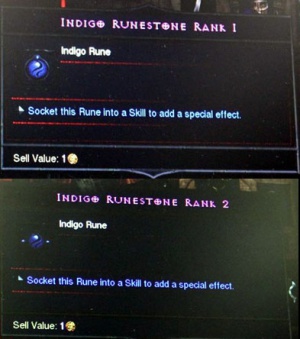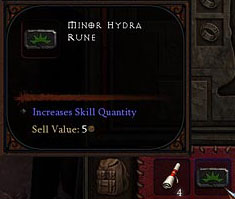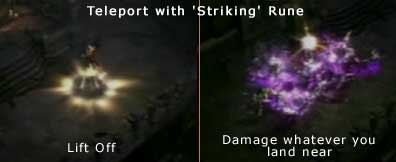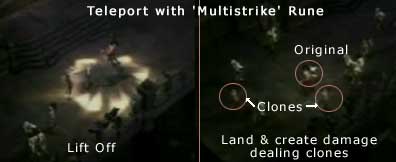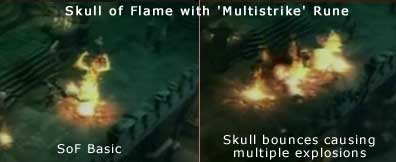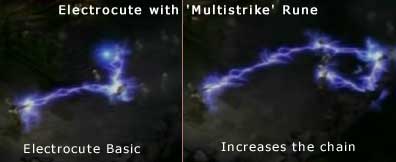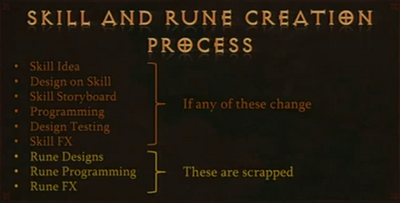Rune Archive

|
Archived Article [e] Rune Archive is an archived article about material previously included in Diablo 3. However, it has currently been removed or the article contains outdated facts. The information is stored in Diablo Wiki for posterity. Please note: Links in this article lead to both updated and archived material. This article was last up to date:
|
See the main runestones page for up to date information about runes. This page archives older runestone info, and traces the evolution of this game system since it was first revealed in 2008.
Contents
Original Rune Functions
Jay Wilson described the five types of runes during an interview from BlizzCon 2009. The quoted sections below are Jay's words: [1]
- "One tends to be more damage-oriented. One tends to multiply effects, splits projectiles or bigger radiuses, things like that. One tends to be a very energy-efficient rune, so you cut down cost or in some way increases the benefit of the skill, so you get more for less. One tends to be more focused on death effects, critical effects. And one of them we call just... the weird rune, which is our grab bag for anything unusual we want to stick on."
Evolution Of The Runestone Naming-Scheme
The names of the Runestones have changed at least twice during development. The original names were very straight-forward, describing what the runes did. They were then changed to a more evocative set of names, which proved too limiting when their functions were overhauled in early 2010, when the names were changed again, to their current color-based names.
The list below traces their name changes over time, from the earliest to the current.
- Unknown > Energy Rune > Golden rune
- Lethality Rune > Viper Rune > Obsidian Rune
- Multistrike Rune > Hydra Rune > Indigo Rune
- Power Rune > Force Rune > Crimson Rune
- Unknown > Striking Rune > Alabaster Rune
Bashiok shed some light on the reason for the latest change in 2010:[2]
- Bashiok: The runes have really just been renamed to allow us greater flexibility in what they do so we’re not creating a weird detachment from what they’re called and the effect they provide. For example what was the multi-strike rune going to do for ... say, Slow Time? And does that match what the name implies, or what you would assume? Probably not.
A few days later, he elaborated:[3]
- Bashiok: ...the purpose of renaming them was... to remove a strict theme. I’m not aware of any rune effects we’ve shown being removed - I think all those still exist just the way they were shown. Just instead of multi-strike/hydra, it’s called Indigo, and while for a lot of skills it still has a very 'multi-strike' theme, it’s not a rule dictated by the name.
Rune Tool Tips
As of the Blizzcon 2010 demo, no rune gave any useful information when hovered over. They simply said, "socket in skills for a special bonus." However, when you click to pick up a rune and hover that over a skill with an open socket, an informative tool tip pops up, explaining in clear terms what the rune will do for the skill.
This isn't always enough to know clearly just how useful the rune will be; experience or screenshots/information on websites (such as this wiki) will be necessary to really understand the strengths and weaknesses of each rune in each skill.[4]
These tool tips were in for the Blizzcon 2010 PvM demo, but most players found that runes still had to be experimented with. For instance, one rune in Magic Missile said the projectile became a homing missile. This sounded good, but when tested the rune just let the Missile change direction, once, and not in a direction the player could control or predict. The effect sort of allowed the Wizard to shoot around a corner, but not very accurately or consistently, and it was not useful to shoot past front row monsters to hit the mages in the rear, since there was no way to make the Missile target the desired enemy.
Not all rune effects are unimpressive, and most are huge ugrades over the base skill, but just reading the description on the tool tip is in no way sufficient for players to make an informed choice. Players will want to read the rune descriptions in this wiki, view movies of the rune effects, and try the runes out themselves, time permitting. Ultimately, the rune tool tips will likely be of most use as a memory aid, reminding players of the rune functions they've seen previously.
Rune Appearance Evolution
As of BlizzCast episode 8 (30th of March, 2009) [5] Runes and Rune Sockets were horizontal rectangles, as seen in the image to the right. Previously, runes and their sockets had been square-shaped.
A more recent image, from August 2010, is seen to the left. Runes are now round, like marbles, and bear striking glyph graphics. In light of this change, it's assumed that the sockets in skills are now round as well.
Rune Function Examples
The D3 Team gave several examples of rune functions during a panel at BlizzCon 2008 when Skill Runes were first revealed as a game feature. (Watch the demonstration on YouTube.) The rune names have all changed since this time. The rune/skill functions have not all changed, but they have been modified somewhat. See the sections further up this page, or on the individual skill pages, for current/accurate information.
Wizard's Mirror Image
Mirror Image Skill: This skill, from the Conjuring Skill Tree, creates a duplicate of the wizard, which is capable of moving around and using spells to attack monsters. (It's not just a decoy or an illusion.)
Hydra/Multistrike Rune: Socketing this rune would increase the number of duplicates. Higher quality levels of the hydra/multi-strike rune would presumably add more duplicates.
Force/Power Rune: Socketing this rune would increase the hit points of each duplicate, and increase the spell's duration.
Wizard's Teleport Skill
Teleport skill: This skill, from the Arcane Skill Tree, teleports the Wizard to the targeted location. The spell isn't quite as quick as it was in Diablo or Diablo 2, since the Wizard leaps up into the air before vanishing, and appears in the air, then falls down to earth.
Striking Rune: Adds damage to targets near where the Wizard appears, functioning something like the Barbarian's Leap Attack skill.
Hydra/Multistrike Rune: Creates a temporary duplicate of the Wizard that will attract enemy fire and will fight and deal damage as well. (This seems to be basically a free way to cast Mirror Image when you Teleport.)
Witch Doctor's Skull of Flame
Skull of Flame skill: The Witch Doctor lobs a flaming skull, grenade style, which explodes on impact, dealing substantial fire damage to nearby targets. Different runes affect this skill in different ways. Here are a couple of examples as presented during a BlizzCon 2008 panel discussion.
Hydra/Multistrike Rune: Socketing this rune causes the flaming skull to skip along the ground, like a stone over water, bounding and creating multiple explosions. Higher quality runes would allow additional bounces.
With Force/Power Rune: Socketing this rune adds a firefield property to the Skull of Flame, creating a small patch of flame on the ground that persists after the skull's explosion and damages any monsters that cross over it.
Wizard's Electrocute
Electrocute skill: This skill, from the Storm Skill Tree creates a strand of lightning that locks onto an enemy like a beam weapon, dealing steady lightning damage.
Hydra/Multistrike Rune: Socketing this rune allows the lightning to chain to multiple targets.
With Viper/Lethality Rune: Socketing this rune causes some of the monsters killed by Electrocute to explode in a nova, dealing damage to other nearby enemies.
Hydra: The First Five Rune Example
The first good example of how runes were going to work in the final game came from Jay Wilson at Gamescom 2010.[6]
- Jay Wilson: One of my favorites is on the Wizard. She has a skill called Hydra, which is largely the same as it was in Diablo 2. Fiery (dragon) heads that shoot fireballs. Depending on which rune the Wizard sockets in that skill, the dragon heads change elements, and it’s a major change. Their entire appearance is altered. They can become poison heads, which shoot bolts of poison that leave pools of acid on the ground. There are lightning heads that shoot Chain Lightning. Cold heads that shoot Frost Bolts that slow enemies. Another rune makes for a bigger fire attack, where the head just breaths a cone of flame.
Jay did not list what all five runes did in Hydra, and his explanation left fans confused. Where were the three elemental damage types coming from? Nothing like that seemed to fit wit the previous rune functions.
This confusion was largely cleared up a few days later when Bashiok spoke privately to Diii.net about this issue, and explained most of the questions left by Jay's new info. [7]
From his words, we were made to understand that in Hydra, the five runes provide: 1) extra damage (with a changed fire form), 2) Multistrike (rapid fire), 3-5) the 3 elemental properties. Extra damage and multishot are consistent with previously known rune functions. One of the elementals comes from the wildcard rune, and the other comes from what used to be the Energy rune. That rune now functions as a second wildcard in many skills, since changes to the resources made the mana-saving property obsolete. (Plus it just wasn't cool enough, in most instances.)
So the only unexpected rune bonuses in Hydra are the 4th and 5th elemental modifiers. The +damage, +multishot, and one elemental damage type would have been expected. The other two would more predictably have granted an Arcane Power cost reduction and some sort of critical hit or death effect bonus. That they were changed to grant elemental bonuses just goes to show how much variability and variety the Diablo III team is putting into the runes.
BlizzCon 2009
Skill Runes were not enabled at BlizzCon 2009, for reasons Jay Wilson elaborated on during an interview after the show:
- Diii.net: They’re still being reworked and you don’t have any further comment?
- Jay Wilson: They’re not being reworked, we had tons of skill runes on the Wizard and the Barbarian but they were so spotty across the entire class we thought it would be more confusing to show them off than to not. So we just disabled them all for the BlizzCon build. But they’re all still there and they work just fine.
During another interview, Jay Wilson explained the creative process of making a rune, and how making any changes at all to the first steps will scrap the end results entirely, as can be seen in the image on the right. [8]
- Jay Wilson: Well, the system is similar for every class. What we did is we broke down five basic runes. Each rune has a general type of effective pluses. One tends to be more damage-oriented. One tends to multiply effects, splits projectiles or bigger radiuses, things like that. One tends to be a very energy-efficient rune, so you cut down cost or in some way increases the benefit of the skill, so you get more for less. One tends to be more focused on death effects, critical effects. And one of them we call just... the weird rune, which is our grab bag for anything unusual we want to stick on.
- Every active skill -- we define an active skill as a skill that you have to click to activate -- can have all five runes affect it. Each rune will change the function of the skill. Some of the changes are minor, there are some cases where there's not much appreciable effect. And then some cases are much more drastic, where for example with Ice Storm or Blizzard, one of the things we're playing around with, this halo of frost whips around her and anyone that moves through it takes damage. That adds on to the effects that Ice Storm already does. So there's a whole bunch of different... the basic idea is to capture that dream of, I'm gonna customize my skills. Even though you and I have the exact same skills, we don't play the same because our skills are different. And then throughout the game, the runes will upgrade in power. So that will just increase and amplify the effect that they have.
Rune Storage
Runes were initially stored in an inventory grid on the skill tree menu; not in the normal inventory. This was changed in development and runes now appear in the main inventory, along with all other items.
Diablo II Runes
- Runes - The main page for D2 runes.
- Rune FAQ - All your questions about runes are answered here.
- Rune list - All the runes in Diablo II, and how you can create a Zod rune from a fourteen trillion Els.
- Runewords - See how runewords work.
- Sockets - Get to know more about the socket mechanic.
Diablo I Runes
The Diablo I expansion, Hellfire added "runes" as a trap-like type of item. Read more about them in the Diablo I Runes article.
Trivia (Rune History)
What do you really know about runes? The ones from our world come from the ancient Vikings, and their "futhark" (equivalence of our 'Alpha Bet(a)') (which again come from the even more ancient Tibetan Yantras). They allegedly hold magic powers, and the magicks of the 'runa' are still practised today. These practices, called "Seden", are of course done mostly as a pastime, but some forms of the old runes were used in proper form as late as early 20th century in the 'Dalarna' area of Sweden...
In Sanctuary, however, runes are magically inscribed symbols. Though their use has changed slightly in the last 20 years, they used to grant (sufficiently prepared) items magical properties. For sages of these runes, magical RuneWords would be created to remake a mundane item into a Runic Item, with powers competing with magical artifacts.
Besides the fact that these supposedly ancient runes hold great and mystic powers, we know little about them. Who created them or how they are created is unknown. They seem to attract demons of different kinds, as they are often found on their corpses. If the runes are of demonic origin is not known either. They could have been the simple writing language of the first inhabitants of Sanctuary, who themselves were more powerful than Demons or Angels. Whatever the origin, they are of great use to heroes wishing to dethrone Diablo or Baal.
References
- ↑ Jay Wilson @ Blizzcon 2009 - IGN, August 23, 2009
- ↑ Bashiok forum post - IncGamers May, 2010
- ↑ Bashiok forum post - IncGamers May, 2010
- ↑ Bashiok forum post - IncGamers May 27, 2010
- ↑ BlizzCast - IncGamers, March 2009
- ↑ Jay Wilson @ Gamescon 2010 - G4TV. August 25, 2010
- ↑ Bashiok @ Diii.net - IncGamers. August 28, 2010
- ↑ Jay Wilson Interview - IGN, June 2009
| Items of Diablo III [e] Item Basics Normal Items Crafting Legendary Armor I Legendary Armor II Legendary Weapons 1h Legendary Weapons 2h Item Sets |
|---|
